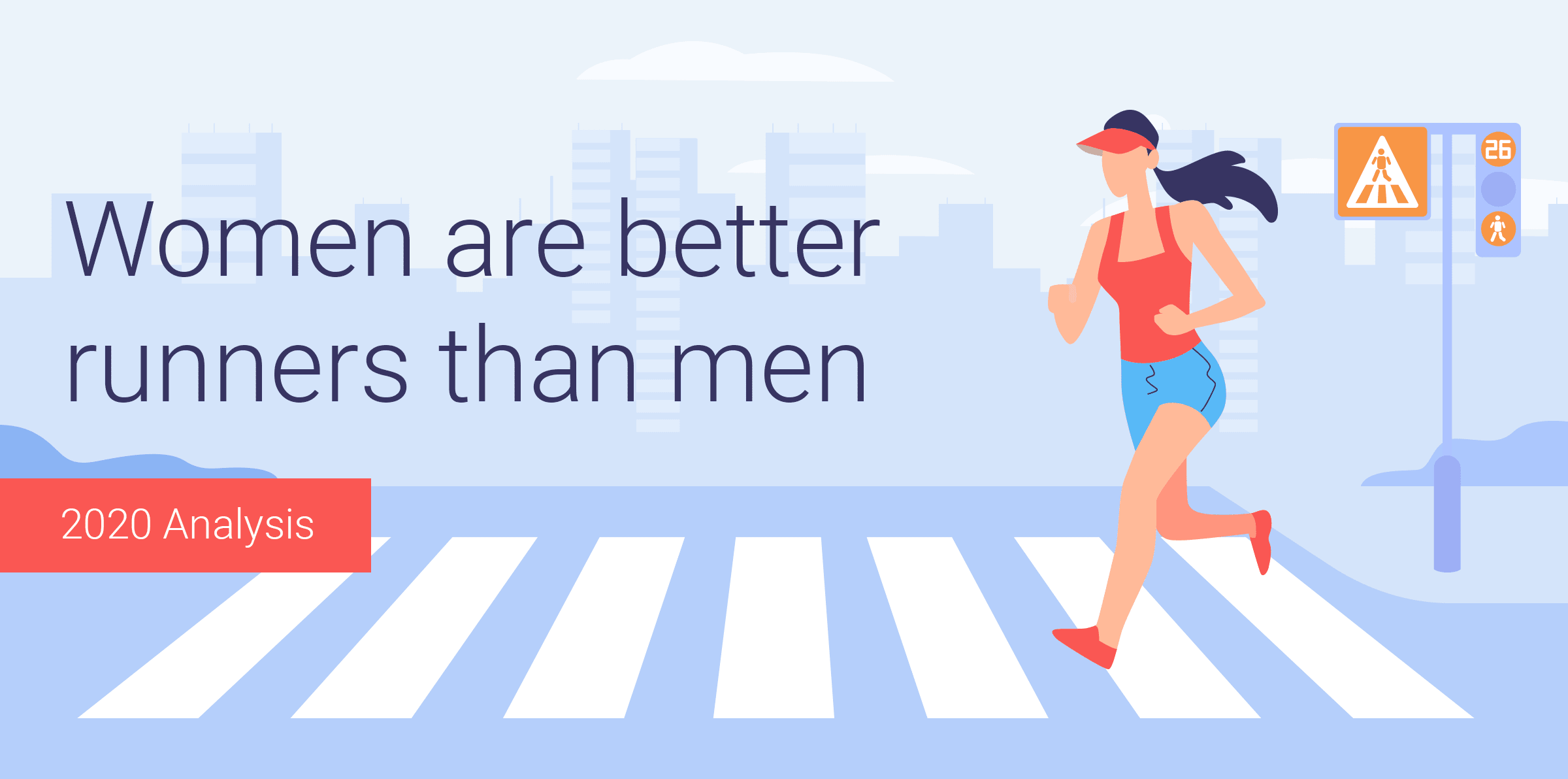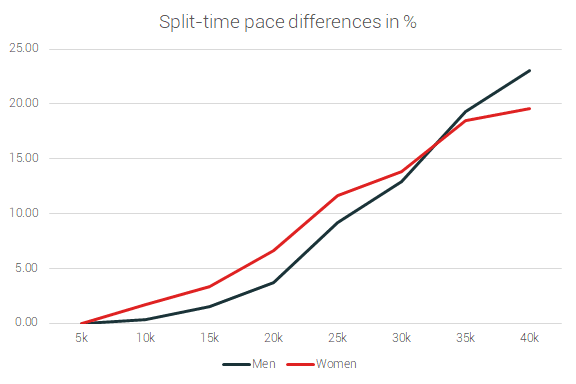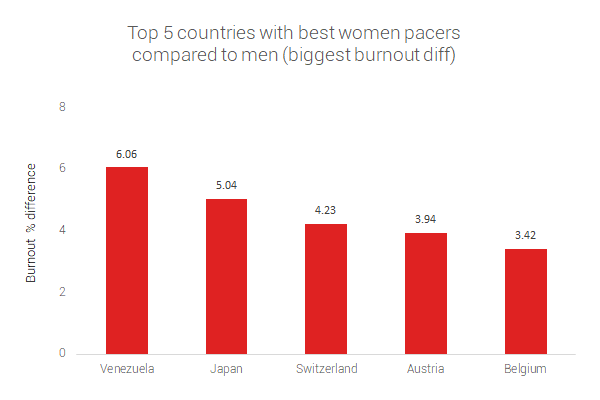Women Are Better Runners Than Men [2020 Analysis]

Faster doesn’t mean better.
This analysis covers 2,348,505 marathon results achieved during the 2009-2019 period. The purpose was to analyse differences in pace throughout the marathon between women and men.
The data has shown that women are 18.33% better at keeping an even pace than men. They burn out less in the 2nd half of the marathon.
You are welcome to use material from this analysis as long as you refer to it. For special requests or questions, email Jovana Subic at jovana@runrepeat.com.
Data and analysis method
- 2,348,505 results from 6 worldwide marathon races (Boston, Berlin, Chicago, London, New York, Paris) achieved from 2009 to 2019 were analysed
- Each runner was categorised by sex, age, country, rank, split results, final result, and year of the performance;
- 2,149,719 participants had sex given. 1,376,441 (64.03%) were men and 773,278 (35.97%) were women.
- 8.48% of participants didn’t report their gender and 10% didn’t report their age;
- For the country-specific analysis, only the nations with at least 2000 participants each year were included to ensure high statistical significance.
- To avoid the influence of extraordinary results on the analysis, outliers were omitted. An outlier was defined as any data point that is 3 standard deviations away from the mean.
Pacing differences: women vs. men
An increase of 14.07% in the average pace for men during the second half of the marathon was observed, as opposed to an 11.49% increase for women, showing that women are 18.33% better at keeping an even pace than men.
| Average pace during the 1st and 2nd half of the marathon | |||
| Gender | 1st half | 2nd half | difference |
| Men | 0:05:43 | 0:06:40 | 14.07% |
| Women | 0:06:26 | 0:07:16 | 11.49% |
Almost 92% of the participants, both women and men, ran the first half of the marathon faster than the second one, even though running at an equal pace is optimal for performance, with the best athletes aiming for such results.
| % of runners that ran the 1st half faster | % of runners that ran the 2nd half faster | |
| Men | 92.24 | 7.76 |
| Women | 92.68 | 7.32 |
| Total | 92.69 | 7.31 |
Men had better average finish times, but women are better at pacing. This stands for both groups: those who ran the first half of the marathon faster and those who ran the second half faster.
Runners who started a bit slower are more likely to run the marathon at a more even pace than those who have started faster, as shown in the table below.
| Average result and pace based on half-distance | |||||
| 1st half avg. result | 2nd half avg. result | 1st half avg. pace | 2nd half avg. pace | %change 1st/2nd half | |
| Men who ran the 1st half faster | 1:56:39 | 2:15:27 | 0:05:32 | 0:06:25 | 13.88 |
| Men who ran the 2nd half faster | 1:52:14 | 1:48:16 | 0:05:19 | 0:05:08 | -3.66 |
| Women who ran the 1st half faster | 2:11:43 | 2:29:17 | 0:06:15 | 0:07:05 | 11.77 |
| Women who ran the 2nd half faster | 2:07:18 | 2:03:16 | 0:06:02 | 0:05:51 | -3.27 |
Split-time pacing differences
For more specific results, the average pace for each 5km throughout a marathon is given. Full split times were recorded for 941,851 (92.4%) male results and 570,655 (84%) female results.
| Average pace by race split | ||||||||
| Distance | 5k | 10k | 15k | 20k | 25k | 30k | 35k | 40k |
| Avg. pace men | 05:26 | 05:27 | 05:31 | 05:38 | 05:56 | 06:08 | 06:29 | 06:41 |
| Avg. pace women | 06:02 | 06:08 | 06:14 | 06:26 | 06:44 | 06:52 | 07:09 | 07:13 |
| % change men | 0.31 | 1.21 | 2.07 | 5.06 | 3.26 | 5.40 | 2.99 | |
| % change women | 1.63 | 1.60 | 3.11 | 4.46 | 1.94 | 3.96 | 0.92 | |
State of ultra running has shown that, the longer the distance, the shorter the gender pace gap. Female ultra runners are faster on average than male ultra runners at distances over 195miles.

Country-specific pace stats
Women who are best at keeping an even pace throughout the marathon have the smallest burnout % (the difference between the pace during the 1st and the 2nd half of the marathon). Top 5 countries with such women are shown below.

When we compare the burnout % of women vs. men, we get the list of top 5 countries where women are best pacers compared to men.

If you’re looking for more data on running, read our study on the state of running: it is the first global mapping of the worldwide running population and, by far, the largest study on running in history.
Pick the right marathon shoes for the right pace
It’s not just about shaving off a few minutes by running in carbon-plated shoes that promise a high energy return. Marathon shoes must be comfortable and should be packed with features necessary for marathon running. The best thing is we test all the shoes in our lab which adds the highest level of objectivity. We combine lab data with our own experience with the shoes.
If you’ve had enough of concrete and asphalt, mix it up with trail running. Fartlek on trails is certainly much better than on the roads. Make sure you pick the right trail running shoes though.
If you’re still unsure which shoes you need, read our Guide on marathon running shoes.
